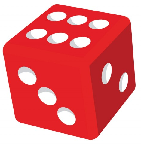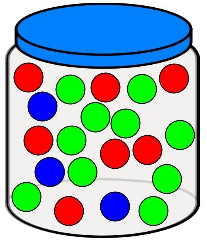
 We roll a standard fair playing die. Calculate the probabilities of the following events:
We roll a standard fair playing die. Calculate the probabilities of the following events:
A: The number shown is a 6.
B: The number shown is greater than 4.
C: The number shown is less than 4.
Solutions: \(P(A)=\frac{1}{6}\approx16.7\%\); \(P(B)=\frac{2}{6}=\frac{1}{3}\approx33.3\%\); \(P(C)=\frac{3}{6}=\frac{1}{2}=50\%\) We roll a fair twenty-sided die. Calculate the probabilities of the following events:
We roll a fair twenty-sided die. Calculate the probabilities of the following events:
A: The number shown is odd.
B: The number shown is a prime number.
C: The number shown is a solution of the equation \(x^2-8x+15=0\).
Solutions: \(P(A)=\frac{10}{20}=\frac{1}{2}=50\%\); \(P(B)=\frac{8}{20}=\frac{2}{5}=40\%\); \(P(A)=\frac{2}{20}=\frac{1}{10}=10\%\) Two standard fair playing dice are rolled. Calculate the probabilities of the following events:
Two standard fair playing dice are rolled. Calculate the probabilities of the following events:
A: The numbers shown are 1 and 1.
B: The sum of the numbers shown is 3.
C: The sum of the numbers shown is 4.
D: The sum of the numbers shown is 5.
E: The numbers shown are equal.
Solutions: \(P(A)=\frac{1}{36}\); \(P(B)=\frac{2}{36}=\frac{1}{18}\); \(P(C)=\frac{3}{36}=\frac{1}{12}\); \(P(D)=\frac{4}{36}=\frac{1}{9}\); \(P(E)=\frac{6}{36}=\frac{1}{6}\)A: The sum of the numbers shown is 3.
B: The sum of the numbers shown is 4.
C: All three numbers shown are equal.
Solutions: \(P(A)=\frac{1}{216}\); \(P(B)=\frac{3}{216}=\frac{1}{72}\); \(P(C)=\frac{6}{216}=\frac{1}{36}\) A standard deck of 52 playing cards consists of four suits:
the hearts (♥), the diamonds (♦),
the spades (♠) and the clubs (♣).
Each suit includes thirteen cards labelled: A (ace or 1), 2, 3, 4, 5, 6, 7, 8, 9, 10, J (jack), Q (queen) and K (king).
We pick one card at random.
Find the probabilities of the following events:
A standard deck of 52 playing cards consists of four suits:
the hearts (♥), the diamonds (♦),
the spades (♠) and the clubs (♣).
Each suit includes thirteen cards labelled: A (ace or 1), 2, 3, 4, 5, 6, 7, 8, 9, 10, J (jack), Q (queen) and K (king).
We pick one card at random.
Find the probabilities of the following events:
A: The card is an ace.
B: The card is a spade.
C: The card is the queen of hearts.
D: The card is not a king.
Solutions: \(P(A)=\frac{4}{52}=\frac{1}{13}\); \(P(B)=\frac{13}{52}=\frac{1}{4}\); \(P(C)=\frac{1}{52}\); \(P(D)=\frac{48}{52}=\frac{12}{13}\)A: The card is an ace or a king.
B: The card is a spade or a club.
C: The card is a queen or a heart.
D: The card is neither a queen nor a heart.
Solutions: \(P(A)=\frac{8}{52}=\frac{2}{13}\); \(P(B)=\frac{26}{52}=\frac{1}{2}\); \(P(C)=\frac{16}{52}=\frac{4}{13}\); \(P(D)=\frac{36}{52}=\frac{9}{13}\)A: Both card are hearts.
B: Both cards are aces.
Solutions: \(P(A)=\frac{{13\choose 2}}{{52\choose 2}}=\frac{1}{17}\); \(P(B)=\frac{{4\choose 2}}{{52\choose 2}}=\frac{1}{221}\) A jar contains 8 blue marbles, 7 red marbles and 5 green marbles. Three marbles are extracted (at the same time).
Find the probabilities of the following events:
A jar contains 8 blue marbles, 7 red marbles and 5 green marbles. Three marbles are extracted (at the same time).
Find the probabilities of the following events:
A: All three marbles are blue.
B: All three marbles are red.
C: There are no green marbles.
D: There is at least one green marble.
Solutions: \(P(A)=\frac{14}{285}\approx4.91\%\); \(P(B)=\frac{7}{228}\approx3.07\%\); \(P(C)=\frac{91}{228}\approx39.9\%\); \(P(D)=1-P(C)=\frac{137}{228}\approx60.1\%\)A: All three representatives are girls.
B: At least one of the representatives is a boy.
Solutions: \(P(A)=\frac{{15\choose 3}}{{25\choose 3}}=\frac{91}{460}\approx19.8\%\); \(P(B)=1-P(A)=1-\frac{369}{460}\approx80.2\%\)A: This student plays football.
B: This student plays football or basketball.
C: This student plays basketball but not football.
D: This student plays exactly one of these two sports.
E: This student plays neither football nor basketball.
Solutions: \(P(A)=\frac{16}{25}=64\%\); \(P(B)=\frac{19}{25}=76\%\); \(P(C)=\frac{3}{25}=12\%\); \(P(D)=\frac{12}{25}=48\%\); \(P(E)=\frac{6}{25}=24\%\)A: This inhabitant reads both magazines.
B: This inhabitant reads at least one of these two magazines.
Solutions: \(P(A)=\frac{900}{6000}=15\%\); \(P(B)=\frac{4500}{6000}=75\%\)(a) if you replace each marble before pulling the next one,
(b) if you don't replace the marbles.
Solutions: (a) \(P(A)=\frac{7}{12}\cdot\frac{7}{12}\cdot\frac{7}{12}=\frac{343}{1728}\approx19.8\%\); (b) \(P(B)=\frac{7}{12}\cdot\frac{6}{11}\cdot\frac{5}{10}=\frac{7}{44}\approx15.9\%\)A: Both marbles are yellow.
B: The first is yellow and the second is blue.
C: At least one of the marbles is yellow.
Solutions: \(P(A)=\frac{7}{16}\cdot\frac{6}{15}=\frac{7}{40}=17.5\%\); \(P(B)=\frac{7}{16}\cdot\frac{5}{15}=\frac{7}{48}\approx14.6\%\); \(P(C)=1-\frac{9}{16}\cdot\frac{8}{15}=\frac{7}{10}=70\%\)A: All three numbers are even.
B: The first number is less than 10 and the other two numbers are greater than 10.
C: The first number is a multiple of 2, the second is a multiple of 3 and the third is a multiple of 4.
D: None of the numbers is a multiple of 9.
Solutions: \(P(A)=\frac{1}{8}=12.5\%\); \(P(B)=\frac{169}{1296}\approx13.0\%\); \(P(C)=\frac{1}{24}\approx4.17\%\); \(P(D)=\frac{63}{64}\approx98.4\%\)(a) We choose an arbitrary student. Find the probability that this student likes prime numbers.
(b) We choose a male student. Find the probability that he likes prime numbers.
(c) We choose a female student. Find the probability that she likes prime numbers.
(d) We choose a student who likes prime numbers. Find the probability that this student is a female.
Solutions: (a) \(P(A)=\frac{133}{500}=26.6\%\); (b) \(P(A|M)=\frac{45}{225}=20\%\); (c) \(P(A|F)=\frac{88}{275}=32\%\); (d) \(P(F|A)=\frac{88}{133}\approx66.2\%\)(a) Find the probability that a person who died last year was a smoker.
(b) Find the probability that a person who died last year was a non-smoker.
(c) Find the probability that a person who died last year had lung cancer.
(d) Find the probability that a smoker who died last year had lung cancer.
(e) Find the probability that a person who died of lung cancer was a smoker.
Solutions: (a) \(P(S)=40\%\); (b) \(P(N)=60\%\); (c) \(P(L)=32\%\); (d) \(P(L|S)=74\%\); (e) \(P(S|L)=92.5\%\)(a) Draw the corresponding tree diagram.
(b) Find the probability that the chosen marble is black.
Solutions: (b) \(P(A)=\frac{3}{5}=60\%\)(a) Find the probability that this black marble was picked from the first jar.
(b) Find the probability that this black marble was picked from the second jar.
Solutions: (a) \(P(H_1|A)=\frac{1}{3}\approx33.3\%\); (b) \(P(H_2|A)=\frac{2}{3}\approx66.7\%\)(a) Find the probability that the second marble is red.
(b) Knowing that the second marble is red, find the probability that the first marble was red too.
Solutions: (a) \(P(A)=\frac{9}{40}=22.5\%\); (b) \(P(H_1|A)=\frac{1}{3}\approx33.3\%\) You toss a coin 4 times. Each time the coin can land in two different ways: one of the outcomes is called head and the other tail.
You toss a coin 4 times. Each time the coin can land in two different ways: one of the outcomes is called head and the other tail.
(a) Find the probability of getting four tails.
(b) Find the probability of getting at least one head.
(c) Find the probability of getting exactly one head.
(d) Find the probability of getting exactly two heads.
Solutions: (a) \(P(A)=\left(\frac{1}{2}\right)^4=\frac{1}{16}=6.25\%\); (b) \(P(B)=1-P(A)=\frac{15}{16}=93.75\%\); (c) \(P(C)=\frac{4}{16}=\frac{1}{4}=25\%\); (d) \(P(D)=\frac{6}{16}=\frac{3}{8}=37.5\%\)(a) Find the probability of getting a 6 exactly once.
(b) Find the probability of getting a 6 exactly twice.
(c) Find the probability of getting a 6 exactly three times
Solutions: (a) \(P(A)\approx40.2\%\); (b) \(P(B)\approx16.1\%\); (c) \(P(C)\approx3.22\%\)(a) Write the table of probability distribution.
(b) Find the expected value \(E(X)\).
Solutions: (a) \(\begin{array}{|l|c|c|c|c|c|}\hline x & 0 & 1 & 2 & 3 & 4 \cr\hline P(X=x) & \frac{1}{16} & \frac{1}{4} & \frac{3}{8} & \frac{1}{4} & \frac{1}{16} \cr\hline \end{array}\) (b) \(E(X)=2\)(a) Write the table of probability distribution.
(b) Find the expected value \(E(X)\).
Solutions: (a) \(\begin{array}{|l|c|c|c|c|}\hline x & 0 & 1 & 2 & 3 \cr\hline P(X=x) & 2.1\% & 17.2\% & 44.3\% & 36.4\% \cr\hline \end{array}\) (b) \(E(X)=2.15\)(a) Find the unknown \(p\).
(b) Find the expected value \(E(X)\).
Solutions: (a) \(p=\frac{1}{20}\); (b) \(E(X)=5.1\)(a) \(P(X=0)\).
(b) \(P(X=1)\).
(c) \(P(X\geqslant1)\).
(d) \(P(X\geqslant2)\).
Solutions: (a) \(P(X=0)\approx16.2\%\); (b) \(P(X=1)\approx32.3\%\); (c) \(P(X\geqslant1)\approx83.8\%\); (d) \(P(X\geqslant2)\approx51.5\%\)